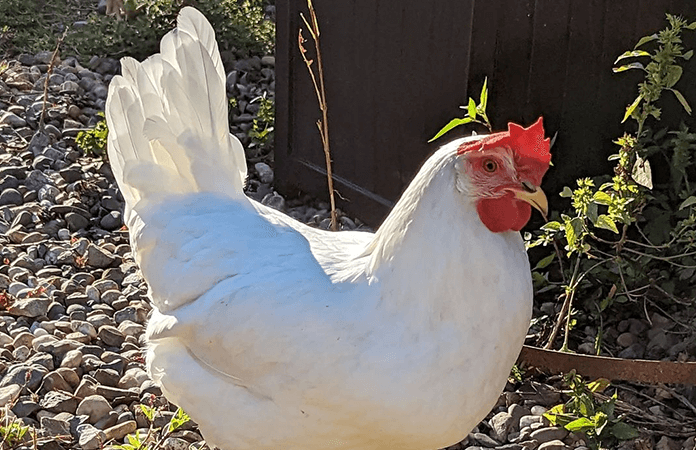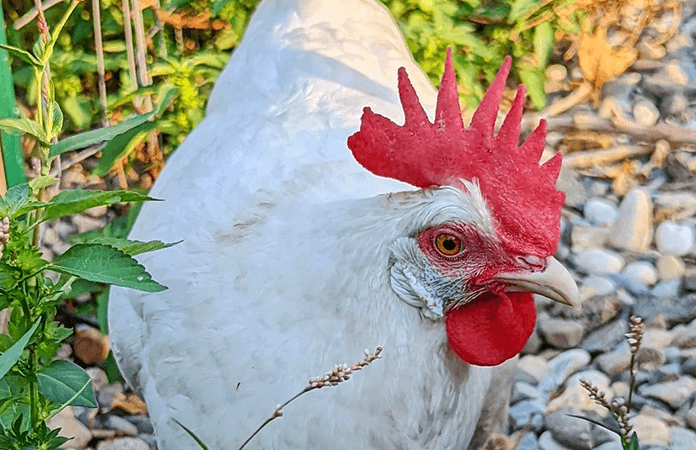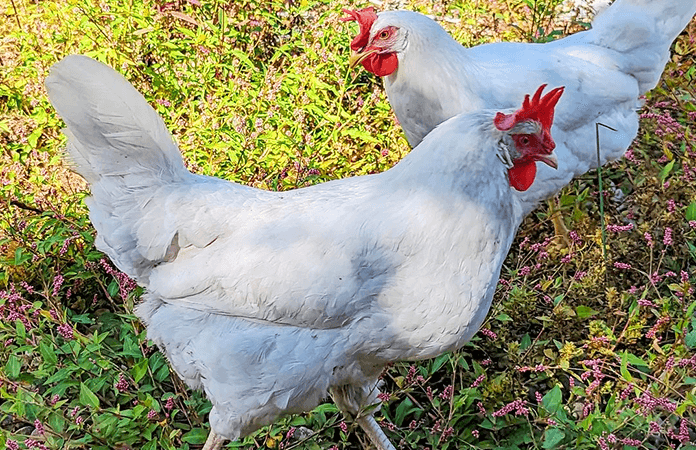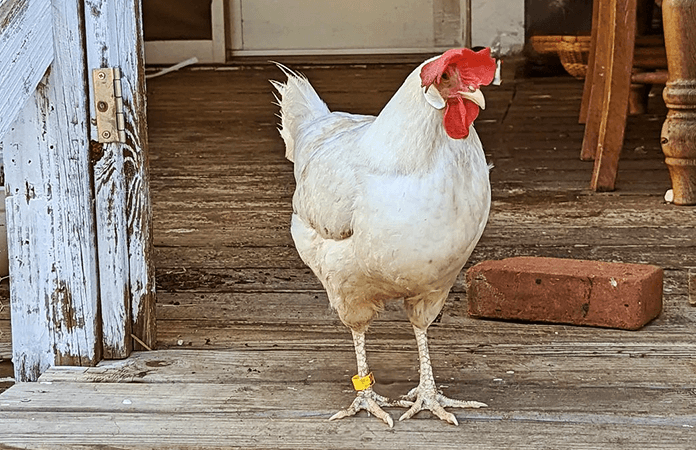White Leghorn: A Favorite Egg Layer

If you’re looking for a hardy, low-maintenance breed that lays almost daily, the Leghorn is an excellent choice! This breed lays up to 6 eggs per week and keeps laying during the winter. Next, they don’t need much extra care besides water, food, and shelter.
Let’s talk more about this favorite egg-maker!
- White Leghorn hens lay 300 eggs per year
- Start laying at early age and keep on laying into old age
- Hardy in all climates
- Beginner-friendly but nervous and flighty
- Not likely to go broody
- 300 Large White Eggs Yearly
- Excellent Feed-to-Egg-Cost Ratio
- Hardy in All Climates
- Active and Flighty
- Not Suited as Meat Bird
- Nervous Birds; No Pet Chickens
Characteristics
White Leghorns are among the most popular chicken breeds in the world. They’re low in maintenance, hardy, and real egg machines. Almost all white eggs you’ll find in your supermarket are White Leghorn eggs or from hybrids developed by them.
| Eggs | 300 eggs per year |
| Egg Color | White |
| Egg Size | Large |
| Weight | 4.5 – 6 lbs |
| Hardiness | Cold and heat |
| Temperament | Friendly and active |
| Beginner-friendly | Yes |
| Color | White |
Their egg-laying skills make them the perfect breed for chicken keepers who aren’t looking for a rare or specific breed but want to enjoy their fried egg every morning. Leghorns bring you a fresh egg almost daily!
White Leghorns are medium-sized birds with beautiful snow-white plumage, bright red comb, red wattles, and white earlobes, which signals they lay white eggs. They have a single comb, although a rose comb is also allowed in some countries. Their legs are clean and yellow; their skin color is also yellow.
Various colors of the Leghorn are recognized, but White is by far the most popular one, next to Brown. Leghorns have an upright stand and narrow breasts; they’re not suited as a meat bird, although in the early days, Leghorns were also used as table birds because of their fast growth. Roosters weigh around 6 pounds (2.7 kg), and females 4.5 pounds (2 kg).
The White Leghorn also has a Bantam miniature version. They often get overlooked as backyard addition, but they are as prolific as their big sisters. Roosters weigh around 26 oz (750 gr), and hens 22 oz (600 gr).

White Leghorn vs. Brown Leghorn
The White Leghorn is a color variant of the Leghorn, just like the Brown Leghorn. Just like Brown Leghorns, White Leghorns have been known to lay extraordinarily well. Any color of Leghorn will provide you with up to 6 eggs per week.
Hatcheries prefer White Leghorns for their egg production of white eggs sold in stores and supermarkets or used in restaurants. Apart from their color differences, the White and brown Leghorns share the same characteristics regarding egg-laying, personality, and free-ranging skills.
The Leghorn Breed
The Leghorn is a Mediterranean chicken that originates from Italy. Leghorn is the English word for Livorno, a city on the west coast of Tuscany, Italy. The breed was exported to Noth America in the first half of the 19th century. After they arrived in 1853 in Connecticut, Leghorns were bred all over New England. In 1865, they were first called Leghorns in Worcester, Massachusetts.

Americans were experimenting with different chicken breeds to improve their own domestic breeds. They soon fell in love with the White Leghorn because of its ability to lay a large number of white eggs all year round.
To ensure the Leghorn’s purity, breeders set some standards in 1871. In 1874, the American Poultry Association added them to the Standard of Perfection. Selective breeding for over 140 years has resulted in beautiful, high-quality birds.
Egg production
As mentioned before, Leghorns are one of the top egg layers in the world. They lay around 290 – 310 white eggs yearly, up to six eggs per week! Their eggs are medium-sized and weigh around 1.9 oz (55gr).
Because of their hardiness, they’ll keep on laying during winter and provide you with a year-round egg supply. Leghorns reach sexual adulthood sooner than most other breeds and start laying at 18 weeks old. They’ll also keep on laying much longer than other breeds and well into older age. Most Leghorns lay well until the age of five or six. After that, egg production decreases significantly.
Leghorns are not known to go broody, but this doesn’t mean it can happen occasionally. But they’re the right breed if you’re not planning to hatch eggs and want to ensure your hens lay all year round.
Personality
Leghorns are friendly and kind birds with dynamic personalities. They are fine to be kept in confinement; however, they love to roam and free-range. Leghorns can be flighty, so ensure the fence is high enough (at least 6 feet high), so they won’t flap or jump over it.

This breed is a great asset to your backyard flock because they’re so low in maintenance. Leghorns have an excellent feed-to-egg cost ratio. They don’t eat that much while bringing you up to six eggs per week. They’re also not likely to catch diseases or get sick; it’s overall a healthy breed with high resistance.
Although Leghorns are friendly chickens and an excellent breed for beginners, they’re not pet chickens that can be kept on your lap and petted. They’re foragers, active birds, and great egg layers, not lap chickens. When looking for a sweet and cuddly breed, the Leghorn is not what you are looking for, and a Silkie, for example, will be a far better option.
As they are both heat and cold hardy, Leghorns can be kept in any climate. But always take extra precautions when extreme weather is on the way, as every chicken needs more care during heatwaves or extreme cold.
Summary
White Leghorns are a perfect match if you’re looking for an egg-laying machine combined with a lovely snowy appearance, hardiness, and high resistance. It’s an ideal addition for any backyard flock for poultry keepers looking for a breed to give them a daily egg supply.
To learn more about chicken breeds, check out our ‘Chicken Breeds Page‘ to see every specific breed we address. Or go to our listicle breed summary on ‘The Classroom‘, or, if you’re unsure where to start, take a look at our ‘Chicken Breeds: Ultimate Beginners Guide‘.






















